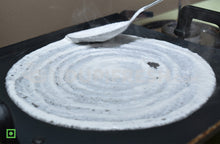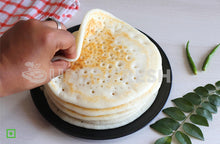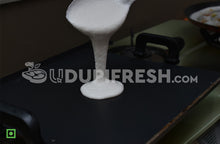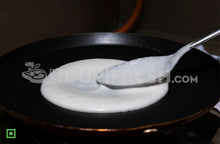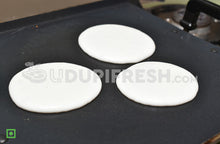
Making Dosa
- Heat a cast-iron pan. When the pan becomes hot, spread ¼ to ½ teaspoon oil all over the pan with a spoon or with a thick paper towel dipped in oil. For a richer taste, you can cook the dosa with ghee or butter.
- Note that the oil should be spread evenly or else it becomes difficult to spread the batter. If the pan is well seasoned you don’t need to spread the oil. I suggest keeping a separate skillet or tawa to make only dosa.
- Do keep the heat on low to low-medium flame, so that you are easily able to spread the batter. If the pan base is very thick, then keep the flame to medium.
- For a low-fat option, just make the dosa without any oil. But make sure that your pan is well seasoned. Otherwise, the dosa will stick to the pan.
- Now take a ladle full of the dosa batter or about ¼ cup of the batter. Pour the batter and gently spread the batter starting from the center and moving outwards.
- Cook the dosa on low to medium heat. Do regulate the heat as per the pan size and thickness. You can even cover the dosa with a lid and let it get cooked from the bottom as I do.
- Cook till the base is nicely golden and crisp. The base will leave the pan and the edges separate when it gets cooked.
- When you see the batter on the top cooked well and the base has become golden, then sprinkle ¼ to ½ teaspoon oil on the edges and center. With the spoon spread the oil on the dosa.
- If you prefer, you can flip the dosa and cook the top side for a minute.
- When the dosa has nicely browned from the bottom and the surface looks well cooked, soft without any specks of undercooked batter, then fold with a spatula and lift it from the pan.
- Make the remaining batches of dosa this way. Keep the leftover batter in the refrigerator for 1 to 2 days or you can freeze it for a week.
- Serve Dosa hot with coconut chutney, potato masala, and sambar. It is best to serve these crispy dosa hot.





